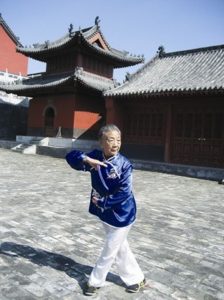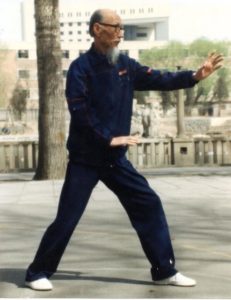Sun Tong, the founder of Yanqingquan was said to have been able to acquire the skills of other martial systems with ease due to his solid foundation. Such a foundation is achieved through the practice of Yanqing Jiazi (The Yanqing Framwork).
Bitterness of Yanqing Jiazi towards excellence in martial skills
Soon after the traditional Yanqingquan (Mizongquan) student commences their journey of practice they are confronted by a great challenge known as Yanqing Jiazi. Jiazi, or Frame/Structure, is the foundation and most important set of practice in Yanqingquan. Whilst in the modern age many have created shorter versions of this set, the original practice is where the value lays. Consisting of over 135 postures and more than 280 movements which can take up to 45-60 minutes with much of the techniques conducted on a single leg or in a low crouching stance, it is no walk in the park. Although initially, practice leads one to sweat profusely and strains the breath, the achievement is to maintain a calm and well harmonized breath throughout, mouth should be closed naturally and the circulation of breath and qi should be consistent. In Yanqing quan it is often expressed “Slowly one trains skills, quickly one trains combat (慢练功,快练攻)” where the ability to undertake slow movements enhances ones precision, effectiveness and speed of attack. Yanqingquan is renowned for integrated the hard and the soft, the fast and the slow.
Mother Fist of Yanqingquan
Yanqing Jiazi is considered the Mother fist of Yanqingquan (Yanqing Quan is also known as Mizong Quan, Mizong Yi and so on). There is an old saying in Yanqingquan ”燕青拳架子功,终生习练不放松|Yanqing Quan Jiazi Gong, Chong Sheng Xi Lian Bu Fangsong ” which essentially means Yanqing Jiazi should be practiced from birth (start) and never given upon ever. Jiazi means frame or structure. What Jiazi actually focuses is thus the achievement of the alignment, strength and balance whilst simultaneously conditioning the musculoskeletal system. Many of the fundamental techniques of Yanqingquan are also within the Jiazi set/routine. Jiazi is fantastic at opening up the body as the muscles/tendons are stretched, strenghthened and co-ordinated The limbs are fully extended, the stances are low and wide, the kicks are clear and precise. To be able to execute all movements with the calmness yet quickness of Yanqingquan requires a very solid foundation. Jiazi is the epitome of such a foundation.
Practice of Yanqing Jiazi
Throughout the course of development a student endures different levels of hardship in the practice of Jiazi which is undertaken through the variations to its practice.
Ding Jiazi (定架子|Stationary Frame) – The first of practise consists of learning the movements within Jiazi. The breath is maintained stable, the movements are conducted at a natural pace (not too fast and not slow) and positions are held for a single breath. The key is learning the movements properly and ensuring the static structures are understood whilst the dynamic lines are clear.
Man Jiazi (慢架子| Slow Frame) – The Slow frame emphasizes the precision of the path of the technique. Whilst in Ding Jiazi it was a macro view or path, now things become smaller so that it is not just an outside hook as an example but the path must be clearly broken down. The breath here becomes longer and more relaxed, the legs require good strength so as to not obstruct technique. This approach is the main practice method and is also known with variants as Dun Jiazi (蹲架子| Low Frame) or Kao Jiazi (靠架子| Strengthening Frame).
Huo Jiazi (活架子| Rapid Frame) – In Huo (lively) Jiazi, given the completion of the strength and precision of movements, the practitioner now applies the light stepping approach of Yanqingquan. Movements become lighter and agile, fast yet not sloppy, strong but not rigid. At certain intervals the techniques can be paused or held, whilst accelerated in others. By the time of Huo Jiazi, the student has already studied other boxing methods and now their strength, power and stability or enhanced across the realms of all their practices.
Dynamic Yoga in a challenging world
Many people suffer with a number of health issues associated with alignment, over-use and incorrect weight distribution. Martial arts methods such as Yanqing Jiazi as an example when trained correctly provide a number distinct exercises and conditioning that will correct and strengthen the practitioner. Thereafter the long and arduous training of Jiazi provides a foundation like no other and essential to the more specific boxing methods trained in Yanqingquan/ Mizongquan. Whilst modern Yoga (Asana based) often allows development of structure through static postures, Jiazi emphasizes the path of movement that can be more challenging from a total coordination view and brings a whole new perspective to physical training.
Iron Leg’s for a Martial Foundation
In martial arts from the Northern Central Plains, the expression adopted by many styles is that “70% of the skills/success are attributed to the legs” – this is does not mean that kicks are used nor does it mean the toughness of the legs from a innate or impact perspective. Rather the expression implies that the ability to support power, to achieve agility and speed, and to provide stability essential in combat are as a result of the foundation from the legs, or lower basin. Yanqing Quan practitioners were often nicknamed Iron legs because of their strength in this regard and such was obtained through the daily practice of Yanqing Jiazi.
Yanqing Jiazi whilst tough in the beginning provides a foundation to last a lifetime and its daily practice allows the body to remain healthy and strong.

![You are currently viewing Yanqing Quan – Yanqing Jiazi [燕青门 – 燕青架子]](http://taipinginstitute.com/wp-content/uploads/2021/08/vfdvfdvfdasv_n.jpg)


